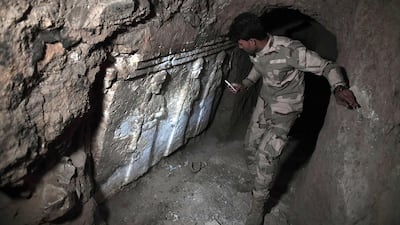MOSUL // Crawl through a labyrinth of narrow tunnels in near total darkness and suddenly they appear: two great winged bulls dating from the Assyrian empire but still intac centuries later.
But as fighting rages to evict ISIL from above ground in Mosul, it will be a race against time to save the archaeological treasures uncovered in the tunnels deep below the main city in northern Iraq.
The tunnels could collapse at any time, meaning the treasures would be entombed forever.
“There are cave-ins in the tunnels every day, ”said Layla Sallih, who is in charge of antiquities for Nineveh province.
The militants dug the network of tunnels under a hill housing the tomb of Prophet Jonah, the Nabi Yunus shrine which they dynamited in July 2014. and then looted the artefacts stored there, selling them on the black market.
Iraqi authorities discovered the underground labyrinth after they recaptured east Mosul at the end of January.
Ms Salih said the artefacts date back to the eighth century BC in the Assyrian period and hail from the palace of King Assarhaddon whose existence in the area was known to Iraqi archaeologists. Some choice pieces survived the looting, such as the two mural sculptures in white marble of the winged bulls, with only the sides and feet showing.
The tunnels lead to bas-reliefs with inscriptions in cuneiform alphabet and two mural sculptures of four women’s faces from the front.
“These finds are very important. They teach us more about Assyrian art. In general, their sculptures show people in profile, whereas here we have women face on,” said Ms Salih.
She said ISIL had not been able to extract many of the treasures for fear of the hill collapsing altogether but other more portable artefacts, especially pottery, were certainly plundered.
Iraqi authorities found 107 items of pottery in a house east of Mosul that were in good condition and most likely exhumed from the tunnels of Nabi Yunus.
After capturing large tracts of territory to the north and west of Baghdad in 2014, the militants set about destroying archaeological and religious sites.
Many shocking scenes were filmed and posted on the internet, such as the destruction of Nimrud, jewel of the Assyrian empire founded in the 13th century BC, with a bulldozer, pickaxes and explosives.
The hilltop of Nabi Yunus is now a picture of desolation, the once elegant Jonah’s tomb reduced to a ruin of smashed and twisted columns.
Iraq’s deputy culture minister, Qais Rashid, told a Unesco conference in Paris last month that at least 66 archaeological sites had been destroyed in the Mosul region alone.
“Some of them [are] transformed into parking lots. Muslim and Christian places of worship have suffered massive destruction, thousands of manuscripts have disappeared,” he said. At the same conference, ministry official Salim Khalaf said more than 700 archaeological items had been exhumed from the tunnels of Nabi Yunus and sold on the black market.
The priority at the site is to carry out studies on how to stabilise the tunnels and save the hill from collapse, Ms Salih explained.
“The security situation in the eastern sector of Mosul is still unstable. There’s fear of (ISIL) drones and terrorist attacks,” she said. “We need foreign expertise, but to have that, security must be improved.”
* Agence France-Presse

